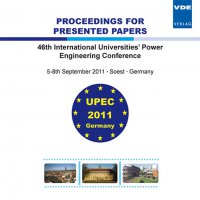Modeling the Electrical Conduction Behavior of Polymers
Konferenz: UPEC 2011 - 46th International Universities' Power Engineering Conference
05.09.2011 - 08.09.2011 in Soest, Germany
Tagungsband: UPEC 2011
Seiten: 5Sprache: EnglischTyp: PDF
Persönliche VDE-Mitglieder erhalten auf diesen Artikel 10% Rabatt
Autoren:
Mertens, Thomas; Jenau, Frank (Institute of High Voltage Engineering, Technische Universitaet Dortmund, Friedrich-Woehler-Weg 4, 44227 Dortmund, Germany)
Inhalt:
For the design of electrical insulation systems the knowledge of the spatial field distribution is essential in order to avoid electrical overstress. Therefore, a simulation model is required taking into account the electron emission and charge transport processes. First, this paper discusses the physical processes of charge emission, transport and trapping. At the cathode-polymer interface the relevant emission mechanisms are the field-relieved thermal Richardson-Schottky emission and the field emission by Fowler-Nordheim. The transport model is based on the continuity equation enhanced by activation processes. According to these mechanisms a physically motivated model is developed and an appropriate computation algorithm is implemented. By the use of the algorithm the time-dependent conduction behavior of polymers is simulated. Measurements of the electrical conduction behavior confirm the characteristic simulation results. Furthermore, the space charge distribution inside the insulation system is analyzed. The analysis elaborates the time dependent space charge distribution as well as the electric field and current density distribution. The major goal of the developed model and algorithm is the simulation of the electric field and space charge distribution aiming at a deeper understanding for the resulting conduction behavior of polymers in order to optimize the design process in an early stage.


